Photo Terminology, Culture, and Propriety; Taking and Making Photographs (Part Three)
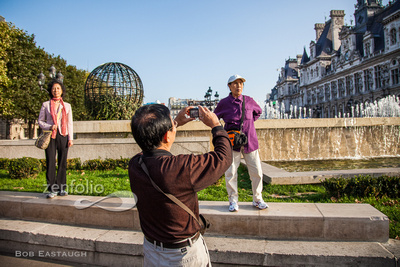

Above: Tourists, Paris, 2011
History plays a part in photo terminology. Some (Ansel Adams, for example) have distinguished on artistic grounds between the terminology of "taking" a photograph (implying more spontaneity and maybe less skill) and the terminology of "making" a photograph (implying thoughtful, conscious, and skilled efforts to create a photograph). For those (like Adams) who used big tripod-mounted view cameras and sheet negative film that they custom-developed in the darkroom before printing, "making" fits well.
Some of these distinctions reflect sensitivities that date back to the first 80 years of photography, when the most burning question was whether photography was an art form. As compared to painting, anything implying spontaneity also implied that the camera was doing all the work, and that the film was just automatically recording whatever was to be seen. Some argued that no process so mechanical could produce art. A lot of energy and words went into the debate about how much effort and thought contributed to early photographs, and whether art resulted. One result was sensitivity to theoretical differences between taking and making photographs. That history is pretty much in the past, thanks partly to the work and words of Alfred Stieglitz and others, and partly to the omnipresence of fine photographic images since the 1930s.
Of course terminology can still cause discomfort. "Snapping" pictures even more clearly connotes a haphazard approach than "taking" them. It is surprising how offended you can be when someone asks if you are getting any "good snaps" while you are obviously using pro-quality gear; you associate "snaps" with little point-and-shoot cameras. Probably no one asked Adams or Weston if they were getting any "good snaps."
But your negative association reflects more about your sensitivities than about either technical reality (current digital point-and-shoot cameras can bring back images Cartier-Bresson's Leicas never could) or modern skill levels. Polaroid prints were derided decades ago, but some great photographs were taken back then with Polaroid consumer cameras, and the current analogy of smartphones has placed in everyone's hands the means to take good pictures and to improve rapidly. The difficulty of operating a complex pro-level camera doesn't count for much in the end result. Image quality ultimately turns on subject-matter selection and composition. You don't get extra-credit for having taken a great picture with a complex camera on full-manual. Whether great pictures are achieved by a full-auto smartphone or a camera on full-manual control doesn't finally matter. Sure, some subjects require certain types of equipment. But Cartier-Bresson could have taken great pictures with a smartphone.
So is there an actual distinction between taking and making photographs? Is some element of effort, time, or thought - some personal investment - essential to the highest achievement? Does difficulty matter? Is a picture taken from your deck in your pjs inherently lesser than one taken after enduring extended discomfort? What are we trying to do, judge the image, or the skill level of the photographer? A pro-level photographer will have much higher percentages of "keepers" - usable, high-quality images - of any given subject under any given set of circumstances, but if all we are doing is blind-grading images, none of that should matter. And likewise, the terminology doesn't matter either.
These images are offered as examples of the role of spontaneity, a factor, like luck, particularly prominent in street and sports photography. These are all "street" photographs in the sense they were taken while the photographer walked about with a camera.
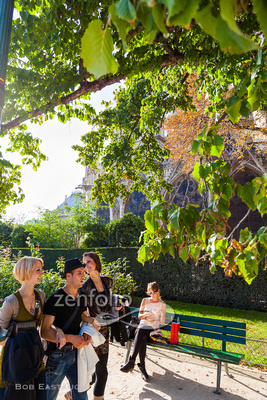

Near Notre Dame, Paris, 2011
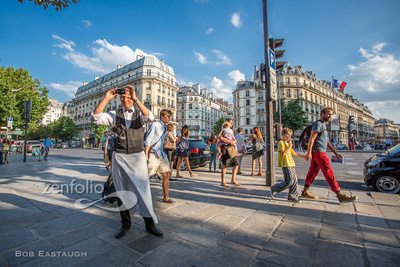

Les Deux Magots, Paris, 2013
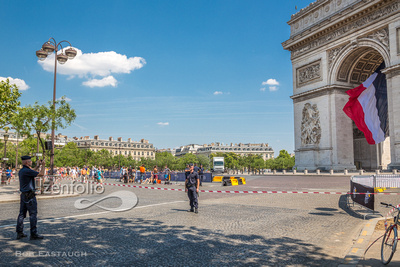

Le Tour de France, Paris, 2013


Rain Showers, Paris, 2013
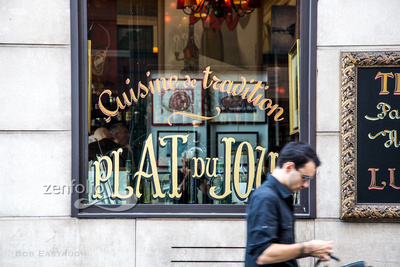

Plat du Jour, Paris, 2014
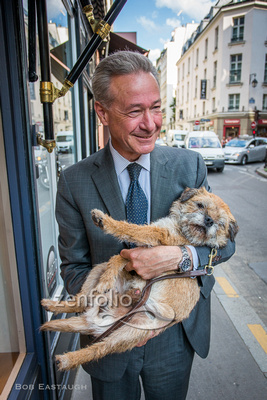

Master and Pet, Paris, 2013
Only one of these, Master and Pet, was taken with consent. All were partly a matter of luck. The dog fully recovered, by the way. In the fall of 2014, we returned to Paris. I delivered prints to the waiter in Les Deux Magots and to the sister of the man in Master and Pet. We never again saw the three glamorous student-friends walking near Notre Dame, nor the girl on the bench. I feel an affinity to them, as much as to the pictures that "captured" them.
If you have any comments, please feel free to express them. Do you think the terminology matters?
Comments


After a lifetime of mainly expressing myself with words, my postings here will mainly rely on images. They will speak for themselves to some extent, but I'll usually add a few comments of explanation. I've taken photographs for decades, since the 1950's, inspired in part by my father's photographic skill. Four years of photo assignments and quality darkroom time eventually gave way to decades of casual and family picture-taking. I re-immersed myself when I left film and turned to digital.